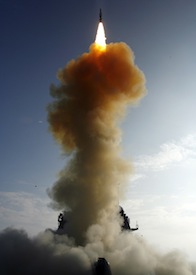Expert Review Questions Effectiveness of Missile Defense Plan
May 18, 2010
Featured Image
Today's top nuclear policy stories, with excerpts in bullet form.
Stories we're following today: Tuesday May 18, 2010
Review Cites Flaws in U.S. Antimissile Program - New York Times [link]
- President Obama’s announcement of his new antimissile plan in September was based on the Pentagon’s assessment that the SM-3, or Standard Missile 3, had intercepted 84 percent of incoming targets in tests.
- A re-examination of results from 10 of those apparently successful tests by Theodore A. Postol and George N. Lewis, being published this month, finds only one or two successful intercepts — for a success rate of 10 to 20 percent.
- The dispute between the academics and the Pentagon centers on whether it is enough for a speeding interceptor to hit the body of a spent rocket moving through outer space or whether it must hit the attached warhead. Dr. Postol says the SM-3 interceptor must shatter the warhead directly, and public statements of the Pentagon agency seem to suggest that it agrees.
- Richard Lehner, an agency spokesman, said the SM-3 is “attaining test scores that many other Defense Department programs aspire to attain.” Even so, the Pentagon later admitted that 4 of the 10 analyzed flight tests carried no mock warheads at all.
- The SM-3 analysis of Dr. Postol and Dr. Lewis, “A Flawed and Dangerous U.S. Missile Defense Plan,” appears in the May issue of Arms Control Today, a publication of the Arms Control Association, a private group in Washington.
Iran’s Nuke Fuel Deal: Breakthrough or Bogus? - Wired's Danger Room [link]
- The Iranian government just announced a deal to send its uranium abroad, in return for fuel for a research reactor.
- In theory, the deal eases a major concern about Iran's nuclear program... Problem is, Iran’s low-enriched uranium stockpile is now larger than when the deal was originally proposed.
- Joseph Cirincione, president of Ploughshares Fund, tells Danger Room, “If Iran carries through — and that is a big if — the deal could buy some breathing space in the continuing crisis… But the May deal is worth less than the October deal… Iran is producing about 125 kg per month, so that could be a total of 2,565 kg by the end of May. Thus the 1,200 kg shipped would represent only half their supply.”
- “Suspicions and mistrust will remain high,” he said. “Western states will continue to believe that Tehran is playing Lucy and the football with the LEU — offering it up for exchange, only to yank it away at the last minute.”
- Ivan Oelrich and Ivanka Barzashka of the Federation for American Scientists told Danger Room that the technical difference between the October deal and the May deal is small — and that Iran is offering up a key opportunity for engagement.
Russia: Iran's Deal With Turkey May Not be Enough - Associated Press
- Russian President Dmitry Medvedev has cautiously welcomed an agreement between Iran, Brazil and Turkey, but added that the deal may fail to fully satisfy the international community.
- Medvedev said that Iran's plans to continue uranium enrichment could continue to cause international worries.
China Welcomes Iran Nuclear Fuel Swap Deal - Reuters [link]
- China has welcomed a nuclear fuel swap plan Iran announced after talks with Brazil and Turkey, urging negotiations over the deepening dispute even as Western powers condemned the new deal as too limited.
- "China has noted the relevant reports and expresses its welcome and appreciation for the diplomatic efforts all parties have made to positively seek an appropriate solution to the Iranian nuclear issue," the Foreign Ministry website quoted him saying.
- "China has consistently advocated safeguarding the international nuclear non-proliferation system. At the same time, China considers we should resolve the Iran nuclear issue through the channels of dialogue and negotiations."
NATO Mission Statement Supports Retaining Tactical Nukes - Global Security Newswire [link]
- A draft version of NATO's new mission statement calls for keeping U.S. tactical nuclear arms in Europe despite rising calls from some alliance states for the withdrawal of the Cold War-era weapons, the Associated Press reported today
- "As long as nuclear weapons exist, NATO should continue to maintain secure and reliable nuclear forces ... at the minimum level required by the prevailing security environment," according to the statement, released today.
- Germany, Belgium and other NATO states have urged removal of an estimated 200 U.S. nonstrategic arms that are thought to be located at six military bases in Belgium, Germany, Italy, the Netherlands and Turkey. The arms are a remnant of the thousands of tactical nuclear weapons deployed at the height of the Cold War.
How Do You Transport Enriched Uranium? - Brian Palmer in Slate [link]
- Iran has agreed to ship 2.65 tons of low-enriched uranium to Turkey… How will the Russians and the French ship 265 pounds of enriched uranium to Tehran?
- In a truck.
- Under World Nuclear Transport Institute guidelines, nuclear shipping containers must pass a series of bruising tests before taking to the road, rails, sea, or air.
- Quality inspectors drop the containers from 30 feet onto a concrete surface, then subject them to a compressive force equal to five times their own weight for 24 hours. Testers drop a 13-pound bar onto the cylinders from three feet. The canister is thrust into a fire for 30 minutes, then immersed in 50 feet of water for eight hours. Each ordeal is followed by a test to make sure the container hasn't gotten too leaky.



